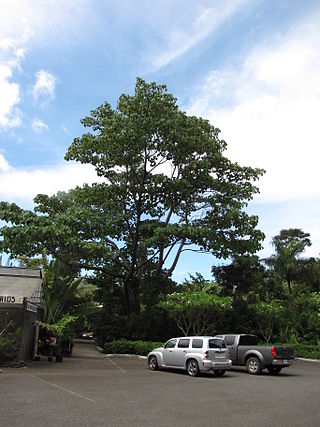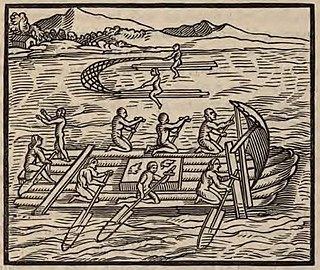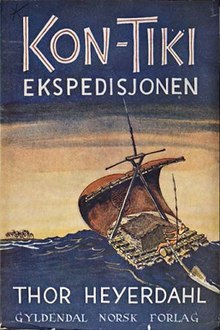
Thor Heyerdahl KStJ was a Norwegian adventurer and ethnographer with a background in biology with specialization in zoology, botany and geography.

Ochroma pyramidale, commonly known as the balsa tree, is a large, fast-growing tree native to the Americas. It is the sole member of the genus Ochroma. The tree is famous for its wide usage in woodworking, due to its softness and its high strength compared to its low density. The name balsa is the Spanish word for "raft."

The Kon-Tiki expedition was a 1947 journey by raft across the Pacific Ocean from South America to the Polynesian islands, led by Norwegian explorer and writer Thor Heyerdahl. The raft was named Kon-Tiki after the Inca god Viracocha, for whom "Kon-Tiki" was said to be an old name. Heyerdal's book on the expedition was entitled The Kon-Tiki Expedition: By Raft Across the South Seas. A 1950 documentary film won the Academy Award for Best Documentary Feature. A 2012 dramatized feature film was nominated for the Academy Award for Best Foreign Language Film.

Torstein Pettersen Raaby was a Norwegian telegrapher, resistance fighter and explorer. He is known as a crew member on the Kon-Tiki expedition.

Knut Magne Haugland, DSO, MM, was a resistance fighter and noted explorer from Norway, who accompanied Thor Heyerdahl on his famous 1947 Kon-Tiki expedition.

Kon-Tiki refers to Scout and Guide raft building competitions held by Scouts South Africa and Scouts Australia. Named after Thor Heyerdahl's Kon-Tiki expedition of 1947, teams of Scouts and Guides age 11 to 17 compete to build and live on a raft for a weekend. Support crews compete in other events while the raft is afloat.

Kon-Tiki is a Norwegian documentary film about the Kon-Tiki expedition led by Norwegian explorer and writer Thor Heyerdahl in 1947, released in Sweden, Norway, Finland, and Denmark in 1950, followed by the United States in 1951. The movie, which was directed by Thor Heyerdahl and edited by Olle Nordemar, received the Academy Award for Best Documentary Feature for 1951 at the 24th Academy Awards. The Oscar officially went to Olle Nordemar.
Kontiki or Kon-Tiki may refer to:

"Kon-Tiki" is an instrumental tune by British group the Shadows, released as a single in September 1961. It was the group's fifth hit and their second to top the UK Singles Chart.

The Tangaroa Expedition of 2006 closely resembled the Kon-Tiki expedition sailing a balsa raft from Peru to Polynesia. Tangaroa outperformed Kon-Tiki by having an improved sail rig and by actively using guaras (centerboards). As such, the expedition represents a scientific continuation of Thor Heyerdahl's experiments in recreated maritime technology.
The Kantuta expeditions were two separate Pacific Ocean expeditions on balsa rafts led by the Czech explorer and adventurer Eduard Ingris in 1955 and 1959, inspired by Thor Heyerdahl's Kon-Tiki expedition, The goal of Ingris's Kantuta expeditions was to repeat the success of the Kon-Tiki and confirm Heyerdahl's theory about the migration of early South Americans to Polynesia.

The Kon-Tiki Museum is a museum in the Bygdøy peninsula in Oslo, Norway. It houses vessels and maps from the Kon-Tiki expedition, as well as a library with about 8,000 books. It was opened in a provisional building in 1949. In 1957, the current building—designed by architects F. S. Platou and Otto Torgersen—was opened. In 1978, an extension of the museum designed by Torgersen was opened.

The snake mackerel is the sole species of fish in the monotypic genus Gempylus, belonging to the family Gempylidae. It is found worldwide in tropical and subtropical oceans between the latitudes of 42°N and 40°S; adults are known to stray into temperate waters. It is found to a depth of 600 meters. Populations of the snake mackerel from the Atlantic and the Indo-Pacific differ in vertebral count and number of first dorsal fin spines, and so may represent separate species.
Kon-Tiki Nunatak is a raft-like nunatak, 1,300 metres (4,300 ft) high, surmounting the Cooper Icefalls in the center of Nimrod Glacier, Antarctica. It was first seen by the northern party of the New Zealand Geological Survey Antarctic Expedition (1961–62) and named after the raft Kon-Tiki which was sailed across the Pacific Ocean from East to West in 1947 by the Norwegian explorer Thor Heyerdahl.

Kon-Tiki is a 2012 historical drama film directed by Joachim Rønning and Espen Sandberg about the 1947 Kon-Tiki expedition. The film was mainly shot on the island of Malta. The role of Thor Heyerdahl is played by Pål Sverre Hagen. The film is an international co-production between Norway, Denmark, Germany, Sweden and the United Kingdom.

Herman Watzinger was a Norwegian engineer in the area of cooling technique from NTH in Trondheim and a crewmember on the Kon-Tiki expedition. He was also a Milorg member during the Second World War operation Polar Bear II, which was brought to Trondheim by Captain Leif Hauge.

Erik Bryn Hesselberg was a Norwegian sailor, author, photographer, painter and sculptor. He is most known as a crewmember of the Kon-Tiki raft expedition from South America to French Polynesia in 1947.

Torgeir Sæverud Higraff is an explorer, teacher and author with special interest in prehistoric transoceanic contact. Like Thor Heyerdahl, Higraff combines history, anthropology and traditional knowledge with expeditions. In 2002, the year Heyerdahl died, Higraff decided to recreate the Kon-Tiki expedition, and in 2006 the Tangaroa Expedition sailed from Peru to Raiatea in eastern Polynesia. Tangaroa outperformed Kon-Tiki by using an improved sail rig and active use of the guara centerboards.

Pre-Columbian rafts plied the Pacific Coast of South America for trade from about 100 BCE, and possibly much earlier. The 16th-century descriptions by the Spanish of the rafts used by Native Americans along the seacoasts of Peru and Ecuador has incited speculation about the seamanship of the Indians, the seaworthiness of their rafts, and the possibility that they undertook long ocean-going voyages. None of the prehistoric rafts have survived and the exact characteristics of their construction and the geographical extent of their voyages are uncertain.

The Kon-Tiki2 Expedition built and sailed two balsawood rafts from Peru to Easter Island in 2015. The goal of the expedition was to show that balsawood rafts can be sailed across long distances, and to collect scientific data in the southeast Pacific. The expedition built two rafts in 30 days and went on to sail the rafts more than 2000 nautical miles before reaching Easter Island after 43 days at sea. No other balsa rafts have sailed to Easter Island in modern times.



















